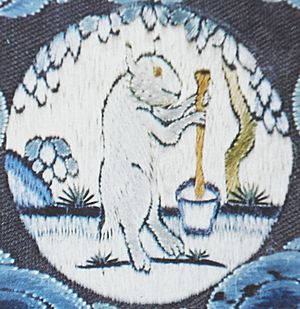Elixir of life facts for kids
The elixir of life is a legendary potion. People believed it could give someone eternal life or eternal youth. This special drink was also thought to cure all diseases. For many centuries, alchemists (people who tried to turn ordinary metals into gold and find magic cures) in different cultures searched for a way to create this elixir.
Contents
What is the Elixir of Life?
The elixir of life is a mythical drink. It was said to make people live forever and stay young. It was also believed to heal any sickness. Many ancient cultures dreamed of finding or making this powerful potion.
History of the Elixir
People have searched for the elixir of life for thousands of years. Different cultures around the world had their own stories and ideas about it.
Ancient Mesopotamia's Search
One of the oldest stories about a life-giving plant comes from Ancient Mesopotamia. This is found in the Epic of Gilgamesh, a very old tale from about 4,000 years ago. In the story, Gilgamesh fears getting old and dying after his friend Enkidu passes away.
Gilgamesh goes on a long journey to find Utnapishtim. Utnapishtim is a special person who survived a great flood and was given eternal life by the gods. Utnapishtim tells Gilgamesh about a plant at the bottom of the sea that can make him young again. Gilgamesh finds the plant, but a snake steals it before he can use it. This old story helps explain why snakes shed their skin, which people saw as a way for them to become young again.
China's Quest for Immortality
Many ancient Chinese rulers wanted to live forever. They hoped to find the fabled elixir. During the Qin dynasty, the first emperor, Qin Shi Huang, sent a Taoist alchemist named Xu Fu on a mission. Xu Fu sailed to the eastern seas with 500 young men and 500 young women. Their goal was to find the elixir on the legendary Penglai Mountain. However, he came back without it.
Later, Xu Fu went on a second trip with 3,000 young girls and boys. None of them ever returned. Legend says he might have found Japan instead.
Ancient Chinese people thought that eating long-lasting minerals like jade or gold could make them live longer. Gold was seen as very powerful because it does not tarnish. The idea of drinking gold appeared in China around 300 BC.
A famous Chinese alchemy book, Danjing yaojue, talks about making elixirs for immortality. It was written by Sun Simiao, a famous doctor. Sadly, many of these substances, like mercury and sulphur, were actually poisonous. They caused serious harm to those who took them. For example, the Jiajing Emperor in the Ming dynasty became very ill from taking a supposed "Elixir of Life" made by alchemists.
India's Amrita
In Hindu scriptures, there is a divine drink called Amrita. It is also known as the elixir of life. The stories say that the devas (gods) were defeated by the asuras (demons). To regain their strength, the god Vishnu told the devas to churn the ocean of milk. This was how they hoped to get the amrita.
In India, the main goal of alchemy was often medicine, not just making gold. Indian elixirs were usually mineral remedies for specific diseases. They were also meant to help people live a long life.
Europe's Philosopher's Stone
In Europe, the elixir of life was closely linked to the Philosopher's stone. This stone was a legendary substance that alchemists believed could turn ordinary metals into gold. It was also thought to create the elixir of life.
Some famous alchemists, like Nicolas Flamel and St. Germain, were said to have created the elixir.
Japan's Waters of Rejuvenation
In Japan, an 8th-century poem collection called Man'yōshū mentions "waters of rejuvenation." These waters were said to be held by the moon god Tsukuyomi.
A folktale from the Ryukyu Islands is similar. In this story, the moon god decides to give humans the water of life. But the person carrying the water gets tired and takes a break. A snake then bathes in the water of life, making it unusable for humans. This story explains why snakes can shed their skin and seem to become young again, while humans cannot.
Many Names for the Elixir
The elixir of life has had hundreds of different names throughout history. Some scholars have found over 1,000 names for it!
Some common names include:
- Amrita: An Indian name meaning "immortality juice."
- Aab-i-Hayat: A Persian name meaning "water of life."
- Philosopher's stone: A European name for the substance that could create the elixir.
- Chashma-i-Kausar: Meaning the "Fountain of Bounty," which Muslims believe is in Paradise.
- Soma Ras: An Indian name meaning "juice of Soma." Soma later came to mean the Moon.
The word elixir itself came from the Arabic name "al iksir," which means "miracle substances." It was not used until the 7th century AD.
Even the name for whiskey in Gaelic (spoken by the Scots and Irish) is uisce beatha. This means "water of life," showing how important the idea of a life-giving liquid was.
See also
- Al Khidr
- Ambrosia and Nectar
- Amrita
- Fountain of Youth
- Holy Grail
- Immortality
- Panacea
- Philosopher's stone
- Potion




